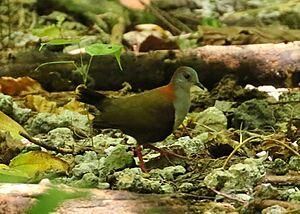Palau ground dove facts for kids
Quick facts for kids Palau ground dove |
|
|---|---|
 |
|
| Conservation status | |
| Scientific classification | |
| Genus: |
Pampusana
|
| Species: |
canifrons
|
| Synonyms | |
|
|
The Palau ground dove (Pampusana canifrons) is a special kind of bird. It belongs to the Columbidae family, which includes pigeons and doves. This unique bird only lives in the forests of Palau, a country made of islands.
Sadly, the IUCN says the Palau ground dove is an endangered species. This means there are not many of these birds left in the world.
Contents
About the Palau Ground Dove
How Scientists Name Birds
Scientists Gustav Hartlaub and Otto Finsch first described this bird in 1872. They found it in Palau and gave it the name Phlegoenas canifrons. Over time, scientists learned more about birds. They changed the group name for this dove a few times. Its current scientific group name is Pampusana.
What Does It Look Like?
This dove is about 21 centimeters (8.3 inches) long. Its forehead and the area around its eyes are a light grey color. The top of its head is a darker grey. The back of its neck and upper back are a warm chestnut brown.
The lower part of its back is olive green. It has shiny bronze colors that reflect the light. Its flight feathers, which help it fly, are dark brown and reddish-brown. There is also a pretty purple patch on its wings.
The throat of the Palau ground dove is a shiny pearly grey. Its chest is a light grey, and its belly is a dark brownish-black. The feathers on its upper tail have green and blackish colors. The feathers under its tail are blackish. This bird has dark brown eyes, a blackish beak, and red legs.
Young Palau ground doves look a bit different. Their forehead and throat are not as bright. They also do not have the purple patch on their wings yet.
Where Does It Live?
The Palau ground dove lives only in Palau. It is one of two types of ground pigeons found there. The other is the larger Nicobar pigeon. The Palau ground dove likes to live in thick forests and woodlands. It prefers islands made of limestone rock more than islands made of volcanic rock.
How Does It Behave?
This bird usually lives alone. It looks for food on the ground, searching through fallen leaves for seeds and fruits. In the mornings and evenings, it calls from the same spot. It makes a soft, steady cooing sound that can last up to two minutes. It also makes a sad, moaning call. Scientists do not know much about how these doves build nests or raise their young.
Protecting the Palau Ground Dove
Why Is It Endangered?
The Palau ground dove is quite rare. However, it is more common on some small islands called the Rock Islands. Scientists believe there are about 600 to 1,700 adult birds left. On some of the smaller islands, the birds are not as threatened. This means their numbers might be staying the same.
However, the Palau ground dove faces dangers from animals that are not native to Palau. These include rats and the brown tree snake. These animals can harm the doves or eat their eggs.
Because the Palau ground dove is rare and has a small population, the International Union for Conservation of Nature has listed it as an endangered species. The country of Palau also protects this bird under its own Endangered Species Act. A survey in 2005 found only two birds on Babeldaob island and two birds on Peleliu island. This shows how rare they are in some areas.


